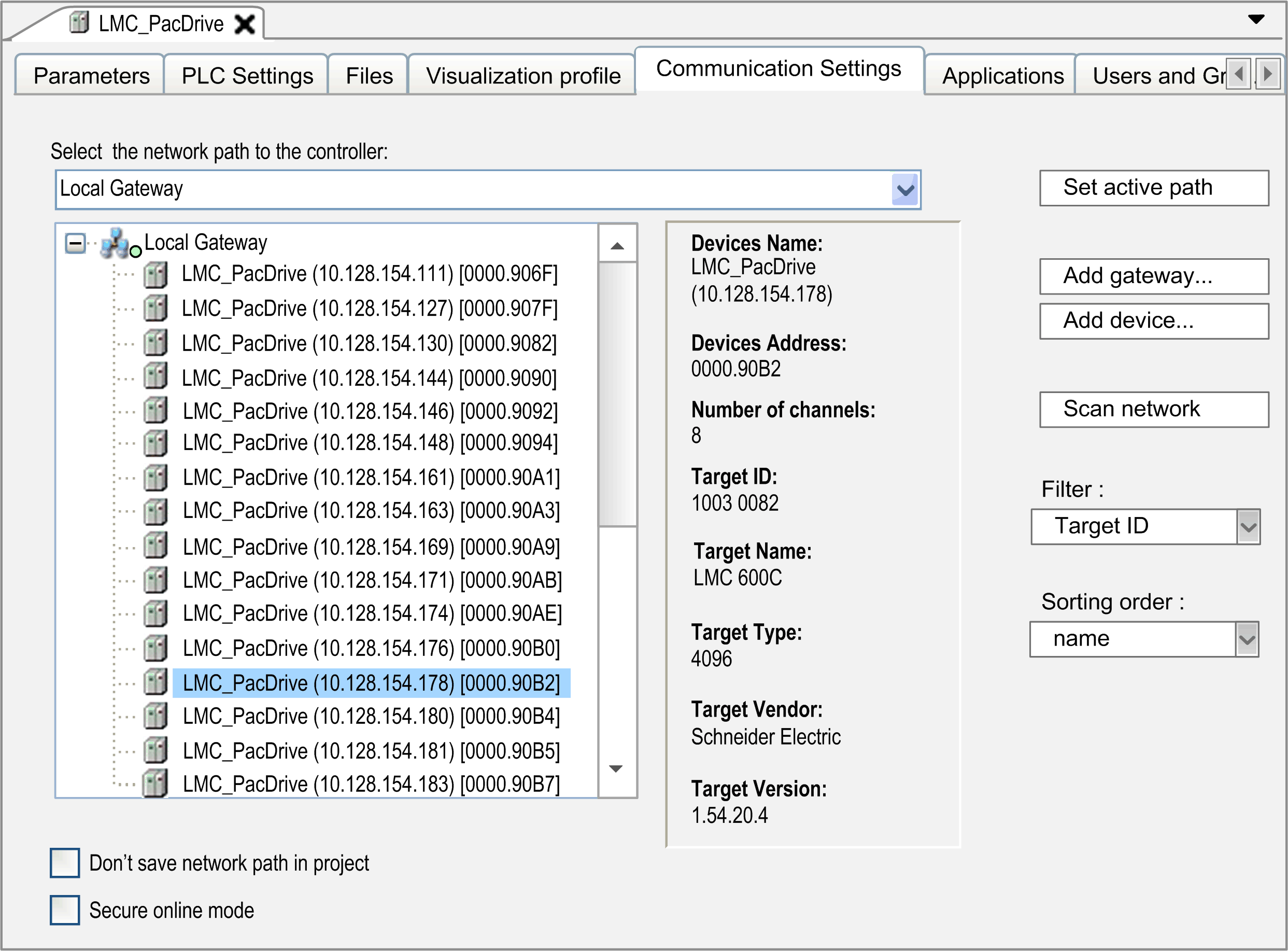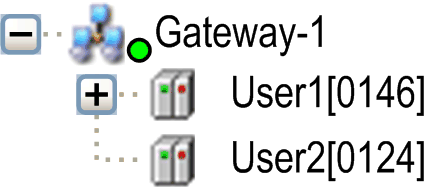Communication Settings in Classic Mode
Overview
The tab in classic mode is displayed when the mode has been selected for the parameter in the dialog box. It allows you to configure the parameters for the communication between device and programming system.
The tab in classic mode provides a tree structure to configure the parameters:

This tab is divided in 2 parts:
-
The left part shows the configured gateway channels in a tree structure.
-
The right part shows the corresponding data and information.
Description of the Tree Structure
When you create the first project on your local system, the local is already available as a node in the tree. This gateway is started automatically during system start.
The settings of this gateway are displayed when you click the button:
Example:
: Gateway-1
: 1217
: 127.0.0.1
: TCP/IP
A status bullet at the bottom right of the gateway symbol indicates the status of the connection:
|
Color |
Description |
|---|---|
|
Red |
Connection cannot be established. |
|
Green |
Connection is established. |
|
Black |
Connection state is undefined. |
Indented below the node (open/close via the / sign), you will see entries for the devices which are reachable through this gateway. The device entries are preceded by a  symbol. Entries with a target ID different to that of the device configured in the project, are displayed in gray font. To obtain an up-to-date list of the available devices, use the button .
symbol. Entries with a target ID different to that of the device configured in the project, are displayed in gray font. To obtain an up-to-date list of the available devices, use the button .

The device nodes consist of a symbol followed by the node name and the node address. In the right part of the window, the respective , , , , , , , and are shown.
In the field, the gateway channel is specified automatically by selecting the channel in the tree structure.
A channel is a connection to a client (such as Diagnostics, Logic Builder, WebVisu, OPC, HMI). Depending on the communication service, a client may occupy more than one channel for a short time. When all channels supported by the controller are being used, Logic Builder displays the message .
Filter and Sorting Function
You can filter and sort the gateway and device nodes displayed in the tree by the selection boxes in the right part of the tab:
-
: Allows you to reduce the entries of the tree structure to those devices with a matching that of the device configured in the project.
-
: Allows you to sort the entries of the tree structure according to the or in alphabetical or ascending order.
Description of the Buttons / Commands
For changing the communication configuration, the following buttons or commands are available:
|
Button / Command |
Description |
|---|---|
|
|
This command sets the selected communication channel as the active path to the controller. See the description of the command. Double-clicking the node in the tree structure has the same effect. |
|
|
This command opens the dialog box where you can define a gateway to be added to the configuration. See the description of the command. |
|
|
This command opens the dialog box where you can manually define a device to be added to the selected gateway entry (Consider the functionality). See the description for adding devices. |
|
|
This command opens the dialog box for editing the settings of the selected gateway. See the description of the command. |
|
|
This command removes the selected device from the configuration tree. |
|
|
This command scans the network for devices which have the address specified here in the configuration tree. Those which are found will then be represented in the gateway with the specified node address and their name. The scan refers to devices below that gateway under which an entry is selected. By default, the command is not available in the menus. Add this command via the menu. |
|
|
This command scans the network for devices which have the names specified here in the configuration tree (case-sensitive search). Those which are found will then be represented in the gateway with the specified name and their unique node address. The scan refers to devices below that gateway under which an entry is selected. By default, the command is not available in the menus. Add this command via the menu. |
|
|
This command scans the network for devices which have the IP address specified here in the configuration tree. Those which are found will then be represented in the gateway with the specified node address and their name. The scan refers to devices below that gateway under which an entry is selected. By default, the command is not available in the menus. Add this command via the menu. |
|
|
EcoStruxure Machine Expert implements the echo service that is similar to the ping tool. In order to verify the quality of the network connection, EcoStruxure Machine Expert sends five echo data packets to the controller. The amount of user data that is consecutively added to these packets depends on the communication buffer size of the controller. A result message is displayed that indicates the average round-trip delay time and the amount of user data that has been echoed through the connection. |
|
|
This command opens a dialog box for the configuration of a local gateway and therefore provides an alternative to manual editing the file Gateway.cfg. See the description of the command. |
|
|
This command starts a search for available devices in your local network. The configuration tree of the concerned gateway will be updated accordingly. |
Description of the Options
Two options are available below the tree structure:
|
Option |
Description |
|---|---|
|
|
Activate this option if the network path definition should not be stored in the project, but in the local option settings on your computer. Therefore, the path setting is restored if the project is reopened on the same computer. It will have to be redefined if the project is used on another system.
NOTE: If you are using SVN, activate this option to help prevent a lock on the device object.
|
|
|
Activate this option if the user should be prompted for confirmation when selecting one of the following online commands: . |